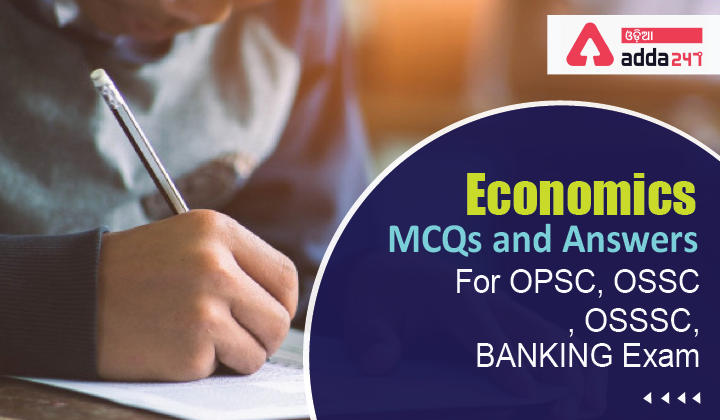Economics MCQs and Answers: Economics are very important for OPSC, OSSC, OSSSC & Other State Exams. Aspirants who are willing to apply for the various Government exams in 2022 must go through the topics of Economics for competitive exams, as Economics is a key part of the syllabus.
Download ADDA247 Odia APP – Appear Latest Exam Test Series & Live Classes
Q1. The rate at which the central bank of any country borrows money from the commercial banks within its own territories
(a)Reverse Repo Rate
(b) Secondary Lending Rate
(c) Repo Rate
(d) PrimaryLending Rate
S1. Ans.(a)
Sol. The rate at which the central bank of any country borrows money from the commercial banks within its own territories is called Reverse Repo Rate.
Current Reverse Repo Rate is 3.35%.
Q2. RTGS in banking sector stands for
(a) Real Time Gross Settlement
(b) Real Transactions Going Settlement
(c) Ready Transfer Gross Settlement
(d) Remittance Transfer Gross settlement
S2. Ans.(a)
Sol.Real-time gross settlement (RTGS) systems are specialist funds transfer systems where the transfer of money or securities takes place from one bank to any other bank on a “real-time” and on a “gross” basis.
Settlement in “real time” means a payment transaction is not subjected to any waiting period, with transactions being settled as soon as they are processed.
Q3. The word “Agricultural shot” is known to be used sometimes in which among the following sports?
(a) Cricket
(b) Hockey
(c) Golf
(d) Polo
S3. Ans.(a)
Sol. The word “Agricultural shot” is related to Cricket.
The shot is a type of slog and is mostly used in street cricket.
Q4. The headquarters of Asia-Pacific Economic Cooperation (APEC) is situated in
(a) China
(b) India
(c) Singapore
(d) Hong Kong
S4. Ans.(c)
Sol.Asia-Pacific Economic Cooperation is a forum for 21 Pacific Rim member economies that promotes free trade throughout the Asia-Pacific region.
Q5.The system of Budget was introduced in India during the Viceroyalty of –
(a) Canning
(b) Dalhousie
(c) Ripon
(d) Elgin
S5.Ans.(a)
Sol. The system of budget was introduced in India during the viceroyalty of Lord Canning.
Q6. Which among the following countries are considered as Tax Heaven countries
(a) Cayman Islands
(b) British Virigin Island
(c) Andora
(d) All of the Above
S6. Ans.(d)
Sol.A tax haven is a country which offersvery low “effective” rates of taxation and financial secrecy for foreign investors.
Countries like, Panama, Andora, British Virigin Island, Cayman Island, Switzerland etc. are Tax Heaven countries.

Q7. Which of the following is/are the main goals of the Codex Alimentarius Commission (CAC)
(a) To protect the health of consumers
(b) To facilitate international trade
(c) To ensure fair practices in the international food trade
(d) All of the Above
S7. Ans.(d)
Sol.Codex Alimentarius Commission (CAC), is an International body established in early November 1961 by the Food and Agriculture Organization of the United Nations (FAO).
The Commission’s main goals are to protect the health of consumers, to facilitate international trade, and ensure fair practices in the international food trade.
Q8. HACCP stands for
(a) Hazard and Critical control Post
(b) Hazard analysis and critical control points
(c) Highway Authority Center for Critical Pathways
(d) Hazard analysis and Critical Circle points
S8. Ans.(b)
Sol. HACCP Stands for Hazard analysis and critical control points.
It is a systematic preventive approach to food safety from biological, chemical, and physical hazards in production processes that can cause the finished product to be unsafe.
Q9. What is approx. the percentage of forest cover in India
(a) 8.5%
(b) 10%
(c) 24%
(d) 19.5%
S9. Ans.(c)
Sol. The Forest Survey of India (FSI) conducted in 2019 estimates a total of 807,276 square kilometres of forest and tree cover, which makes up 24.56% of the land area.
Q10. Which of the following are considered to be the four pillars of human development?
(a) Equity, inclusion, productivity and empowerment
(b) Equity, productivity, empowerment and sustainability
(c) Productivity, gender, inclusion and equity
(d) Labour, productivity, inclusion and equity
S10. Ans.(b)
Sol. Four basic pillars of human development: equity, sustainability, productivity, empowerment.
Q11. Which one of the following is not correct about Repo rate?
(a) It is the interest rate charged by the Central Bank of overnight loan
(b) It is the interest rate paid by the commercial banks on overnight borrowing
(c) It is the interest rate agreed upon in the loan contract between a commercial bank and the Central Bank
(d) It is the cost of collateral security.
S11. Ans.(b)
Sol. Repo rate is that rate at which the Central Bank of the country (in case of India, it is RBI) lends money to the commercial banks in the event of any shortfall of funds.
Repo rate is used by the monetary authorities to control inflation.
It is the interest rate which is paid by the commercial banks on overnight borrowing.
Q12. Which one of the following economists proposed the LPG model of economic development in India?
(a)Y.B. Reddy
(b)K.V. Kamath
(c)Manmohan Singh
(d)None of these
S12. Ans.(c)
Sol. The economy of India had undergone significant policy shifts in the beginning of the 1990s. This new model of economic reforms, commonly known as the LPG or Liberalization, Privatization and Globalization modelwas proposed by Dr. Manmohan Singh, economist and finance minister of India at that time under PV Narasimha Government.
Q13.As per the census 2011, what is the density in india?
(a)325.
(b) 352.
(c)372.
(d)382.
S13. (d)
Sol. The population density of india has risen to 382 persons square km. In 2001 the figure was 325.
Q14. Which State of India has the largest percentage of Poor’s?
(a)Bihar.
(b) Chattisgarh.
(c) Orissa.
(d)Jharkhand.
S14. (b)
Sol. As per the RBI estimates chattisgarh has the highest poverty level with 39% people living below the poverty line.
Q15.Which of the following is deducted from NNP to arrive at NI?
(a) Indirect tax.
(b)capital consumption allowance.
(c) subsidy.
(d) interest.
S15. (a)
Sol. National income in economics term can be defined as NET national product+ subsidy-indirect taxes.
Geography MCQs and Answers For Odisha Exam
History MCQs and Answers For Odisha Exam
Reasoning MCQs and Answers For Odisha Exam














